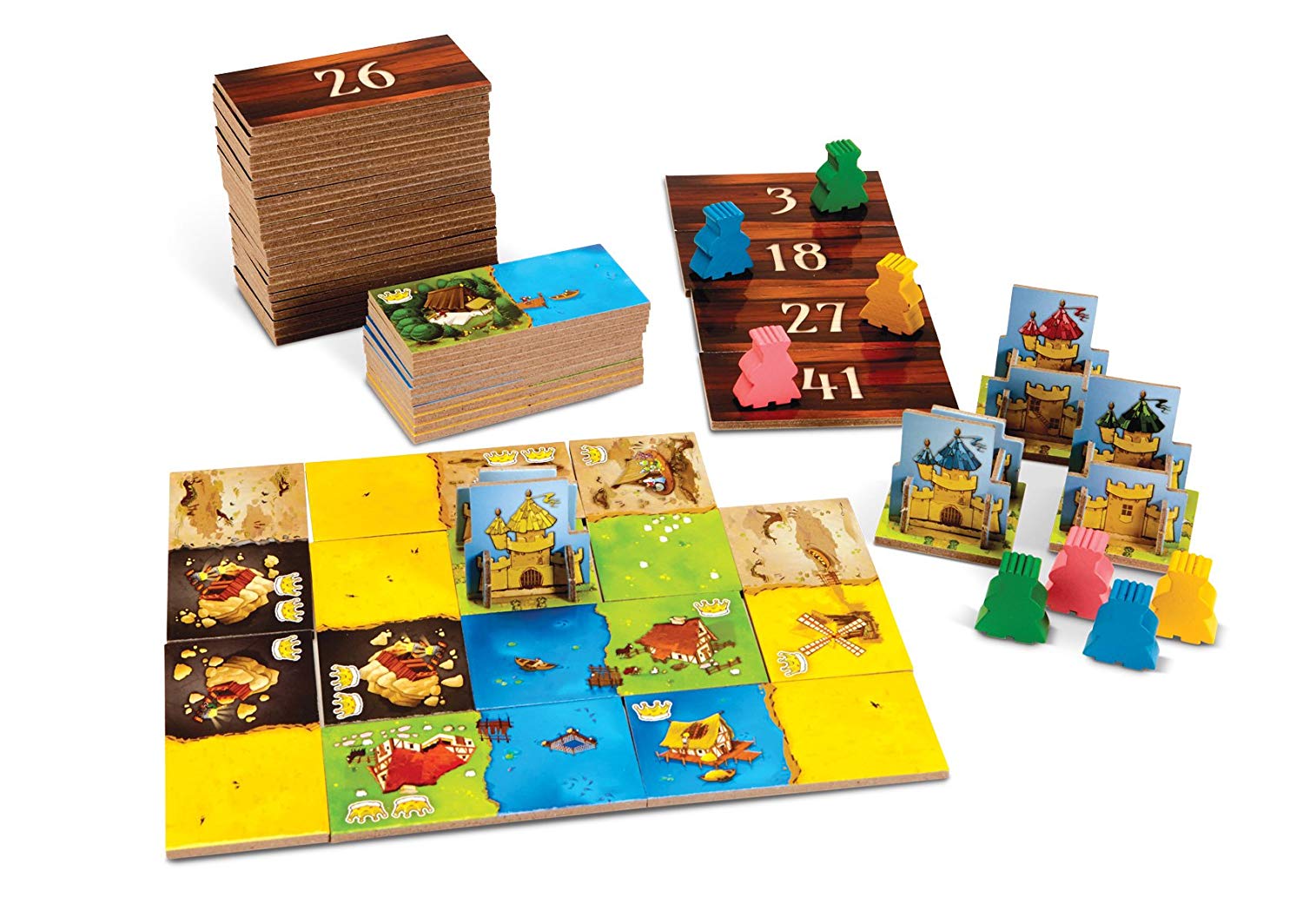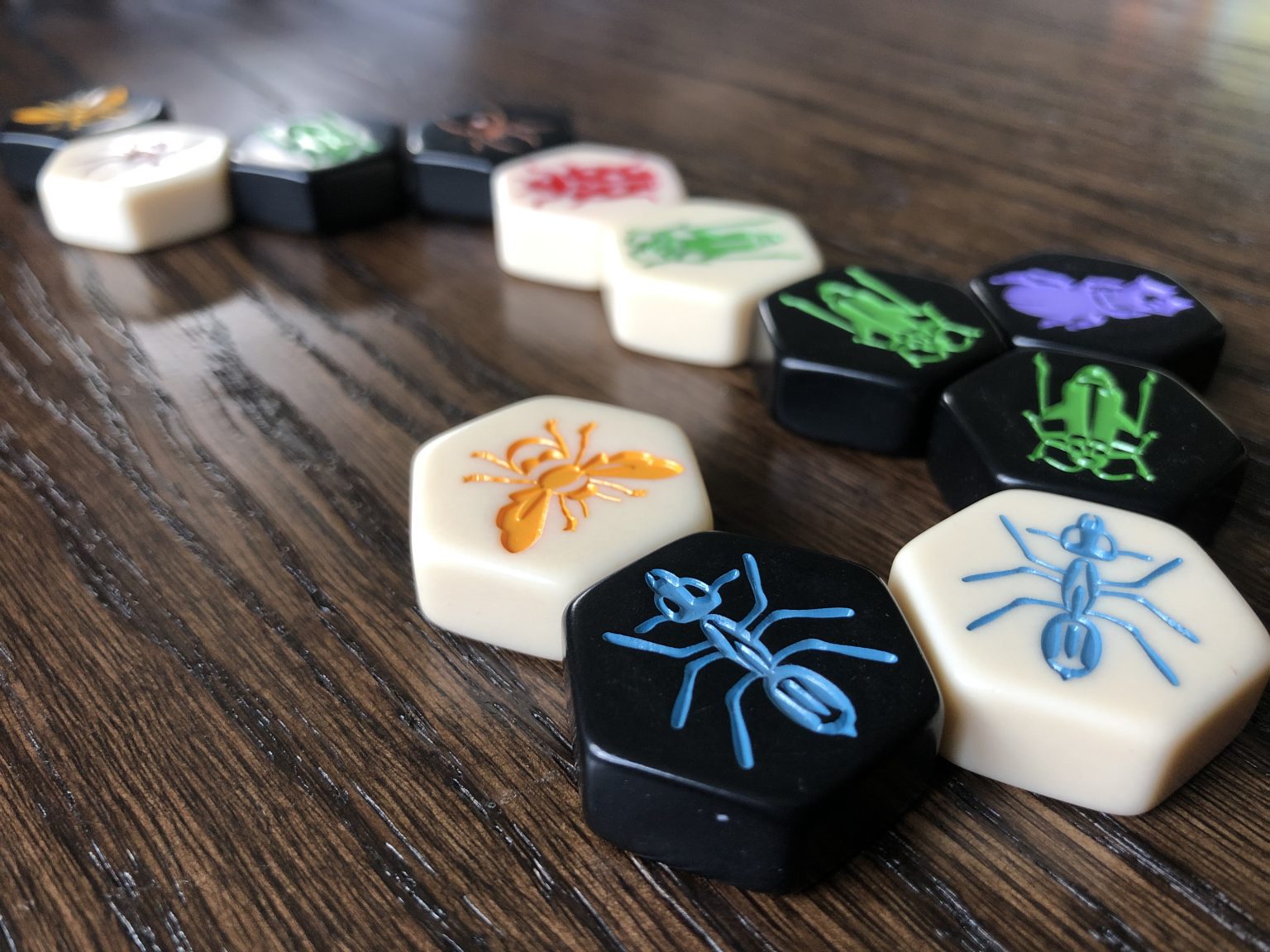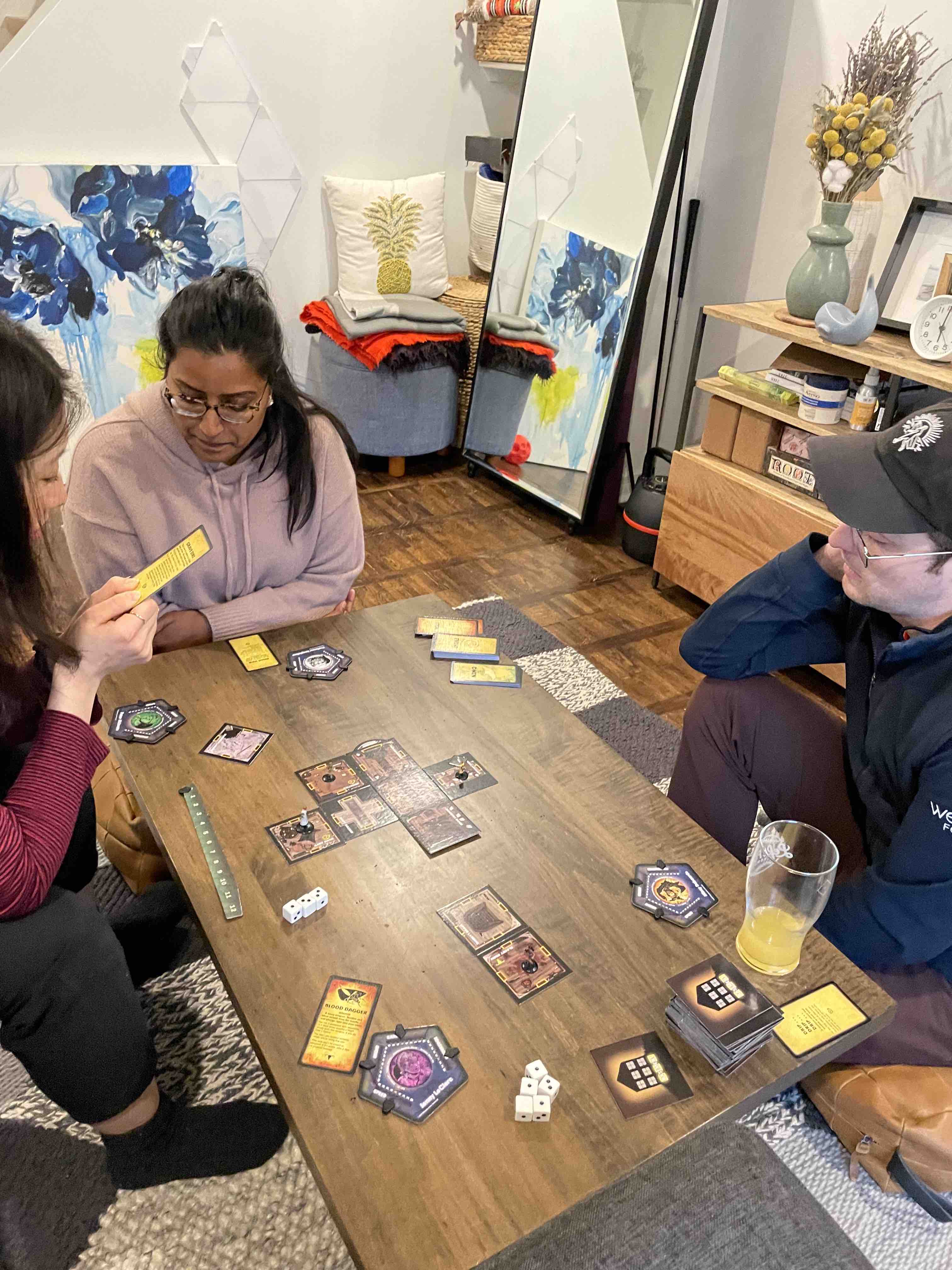My wife and I are incredibly competitive when it comes to playing board games. In fact, we prefer playing competitive two-player board games over co-operative board games a majority of the time!
Over the years we tested out loads of competitive two-player board games. And, instead of playing your standard Scrabble, Sorry! or even Settlers of Catan, we reach deep into our collection and always seem to pick some truly awesome ones.
So, whether you’re playing at a café with a friend, while at work with a colleague, or at home Netflix’n with your boo, here are the best competitive two-player board games.
Article Contents:
- Kingdomino · 15 – 20 mins · 2 to 4 player
- Splendor · 25 – 35 mins · 2 to 4 player
- Hive · 15 – 20 mins · 2 player
- 7 Wonders Duel · 30 – 40 mins · 2 player
- Patchwork · 25 – 35 mins · 2 player
- Carcassonne · 35 – 45 mins · 2 to 5 player
Gameplay: 15 to 20 minutes
Players: 2 to 4
Transportability: High
Difficulty to Learn: Low
Setup Time: 2 minutes
Expansions: Yes
Price: $25 – $35

At its root, Kingdomino is a tile building game that is based on aspects of dominoes (the game, not the pizza chain).
The goal is to build a 5 x 5 kingdom around your castle and earn the most points based on the number of connected terrain territories.
Quick Rules
The board game contains 48 domino tiles but only 24 are required for a two-player game. Each tile contains two terrain squares. There are 6 types of terrain: farm, forest, grassland, mine, sea and swamp. Some terrain squares also contain a crown symbol, which is important for scoring. The back of each tile is numbered 1 to 48.
To start the game, the tiles are shuffled. Four tiles are drawn and arranged smallest to largest, then flipped over to reveal the terrain side.
Each player has one colored castle tile and two colored meeples. Player one places one meeple on one of the four tiles. The second player then places their meeple on one of the three remaining tiles. The first player places their second meeple, followed by the second player. Immediately, four tiles are drawn, arranged smallest to largest, then flipped over.
During each round, the player on the lowest ranked tile moves his meeple and selects a newly drawn tile. The tile then placed next to the player’s castle. Likewise, the meeple on the next lowest ranked tile is moved and the tiles is placed, so on and so forth. The process is repeated until all 24 tiles have been drawn.
When tiles are placed, they can only span a maximum of a 5 x 5 square. Additionally, when placing a tile, at least one of the terrains need to match where it is placed. If the terrain doesn’t or can’t match, or there is no room to add a tile (5 x 5 limit), the tile must be forfeited.
The game is over once the last tile is placed. Scoring is based on horizontally and/or vertically connected terrain territories. Each crown on a connected territory counts as a multiplier. But, territories only count for points if at least one crown is present. So, if you have a territory with 3 sea terrain squares connected, with 2 crowns, you score 6 points.
Why it’s Great
Constantly struggling between selecting the highest earning tiles and being able to pick new tiles first makes Kingdomino a legitimate grudge match from the get-go. Now, include the added constraint of matching terrain squares and being limited to a 5 x 5 square plot, you’re in for a highly competitive game to say the least!
The low set-up time, simple rules and high re-playability makes Kingdomino an easy winner in our books. So, if you’re like us, you’ll be playing this competitive two-player board game more often than not.
Looking for the complete rules to play Kingdomino? Check them out here.
Gameplay: 25 to 45 minutes
Players: 2 to 4
Transportability: Medium
Difficulty to Learn: Medium
Setup Time: 5 minutes
Expansions: Yes
Price: $35 – $40

Just like the Kentucky Derby, Splendor relies on patience, persistence and perseverance.
It’s a mad dash to collect gem tokens and gem cards to ultimately gain prestige points. But, at the end, only one player is crowned the champion.
Sometimes it’s a landslide victory, while other times it’s truly a photo finish!
Quick Rules
The first player to reach or exceed 15 prestige points wins. To get prestige points, you need to purchase prestige gem cards. To purchase prestige gem cards, you need to have either enough tokens (chips) and/or gem cards.
And to get gem cards, you need to purchase them with tokens. Finally, to get tokens, you can pick them up 3 (or two) at a time on your turn. Phew! That’s the game in a nutshell.
There are 5 standard colours of tokens to choose from, the total of each colour token depends on the number of players. There are also 3 tiers of gem cards (green, yellow and blue), each progressively more expensive to purchase, but each more rewarding than the previous tier.
On your turn, you have three options:
- You can (1) pick up two of the same tokens (if all tokens of that colour are available) or three tokens (each of a different colour) and add them to your stack from the bank.
- (2) Purchase a gem card with the corresponding number of tokens/gem cards, and add the purchased card to your stack.
- Or (3) reserve a card for yourself for purchase at a later time, collecting a gold token in the process, which counts as an universal colour token.
Why it’s Great
Splendor is an epic battle for prestige points supremacy. When played with two players, you are constantly anticipating your opponents next move while planning your own.
It’s an intense game for competitive players that feels like a chess match at times. The expansions also offer alternative ways of playing so it never gets repetitive.
It’s a battle royale, without the bloodshed!
Looking for the complete rules to play Splendor? Check them out here.
Gameplay: 15 to 20 minutes
Players: 2
Transportability: High
Difficulty to Learn: Low
Setup Time: 1 minute
Expansions: Yes
Price: $20 – $35

A fantastic, multi-faceted two-player board game, 7 Wonders Duel feels a lot like a real-time strategy game (i.e. Age of Empires). No internet connection required!
Quick Rules
The ultimate head-to-head game of conquest, 7 Wonders Duel pits players to collect resources, advance their military and/or scientific development, and establish a civilization complete with wonders.
There are three ages (or rounds) of cards that are set up. Cards are set up in a specific pattern, face up and face down during each round. Players take turns selecting available cards to be either added to their stack, discarded for coins, or used towards constructing a wonder.
Building a wonder results in some sort of bonus. Resource cards such as water, wood, brick, stone and paper are required to build wonders. Coins can also be used to purchase resources in-lieu of resource cards.
Military conquest, scientific achievement and victory points cards are also available to be selected. Players can win by military conquest (selecting military cards and advancing to your opponents capital), scientific supremacy (collecting 7 different scientific development cards) or, if neither occurs, by total victory points at the end of the game.
Why it’s Great
Battling over resources and building wonders, while also not being defeated militarily or scientifically – each match can be an emotional rollercoaster!
7 Wonders Duel can feel like a grudge match. This strictly two-player board game is a solid choice for competitive-minded players.
Looking for the complete rules to play Hive? Check them out here.
Gameplay: 35 to 45 minutes
Players: 2
Transportability: Low
Difficulty to Learn: Medium
Setup Time: 10 minutes
Expansions: No
Price: $40 – $45

A fantastic, multi-faceted two-player board game, 7 Wonders Duel feels a lot like a real-time strategy game (i.e. Age of Empires). No internet connection required!
Quick Rules
The ultimate head-to-head game of conquest, 7 Wonders Duel pits players to collect resources, advance their military and/or scientific development, and establish a civilization complete with wonders.
There are three ages (or rounds) of cards that are set up. Cards are set up in a specific pattern, face up and face down during each round. Players take turns selecting available cards to be either added to their stack, discarded for coins, or used towards constructing a wonder.
Building a wonder results in some sort of bonus. Resource cards such as water, wood, brick, stone and paper are required to build wonders. Coins can also be used to purchase resources in-lieu of resource cards.
Military conquest, scientific achievement and victory points cards are also available to be selected. Players can win by military conquest (selecting military cards and advancing to your opponents capital), scientific supremacy (collecting 7 different scientific development cards) or, if neither occurs, by total victory points at the end of the game.
Why it’s Great
Battling over resources and building wonders, while also not being defeated militarily or scientifically – each match can be an emotional rollercoaster!
7 Wonders Duel can feel like a grudge match. This strictly two-player board game is a solid choice for competitive-minded players.
Looking for the complete rules to play 7 Wonders Duel? Check them out here.
Gameplay: 25 to 35 minutes
Players: 2
Transportability: Medium
Difficulty to Learn: Low
Setup Time: 4 minutes
Expansions: No
Price: $30 – $35
A fair warning: If you or your partner have OCD you will either fall in love or come to hate this game.
Case in point, my wife, who obsesses over puzzles, is on a personal quest to beat her high score of 37!
[For your information, first timers usually do well if they score a non-negative number…]
Quick Rules
The name of the game is to complete the highest-scoring “quilt” on your personal 9 x 9 game board by purchasing and placing “patches” (essentially jigsaw pieces) onto your quilt.
Each player starts with 5 “buttons” (equivalent to 5 points). A starter marker signifies the beginning of the patches, arranged in a circle around the time tracking board.
On a turn, a player can pass or purchase one of the three patches available clockwise from the starter marker. You pay the cost in buttons shown on the patch, move the starter marker to the position of the patch, add the patch to your game board and advance your player token on the time tracking board the number of spaces indicated on the patch.
If your player token is behind or on top of your opponent’s token you take another turn. If you pass on your turn, move your player token to one space in front of your opponents, and take one button for every space you moved.
During the game, if you pass a button icon on the time tracking board, you collect button income equivalent to the number of buttons from the patches on your personal board.
Once you reach the center of the time tracking board, count the number of buttons you have and subtract two buttons for every space on your quilt that is empty.
The player with the most points (which can be a negative number!) wins.
Why it’s Great
Although strictly a two-player board game, Patchwork is an endless quest to best your own previous score.
It’s challenging enough that you want to play games back-to-back, but not to the point where you overlook it.
Check out this obscure board game that’ll have you battling for buttons.
Looking for the complete rules to play Patchwork? Check them out here.
Gameplay: 25 to 45 minutes
Players: 2 to 5
Transportability: Medium
Difficulty to Learn: Medium
Setup Time: 2 minutes
Expansions: Yes
Price: $35 – $45

When you’re itching to play a two-player board game that’s both competitive and quick, Carcassonne is the game to play.
Setup consists of taking out the scoring board, choosing a color of “followers” and mixing up the game tiles face-down in the box. That’s it!
Quick Rules
A starter tile is placed face-up in the center of the playing table. Players then take turns choosing tiles randomly and placing them face up on the table, connecting new tiles to the existing tile(s). Tiles must fit together such that the “border” of the tiles work together.
A new tile, when connected to an existing tile, completes the map without producing a fallacy, such as a road ending abruptly, a field-edged tile connected to a city-edge tile, etc.
After placing a tile, the player can take one follower from his/her supply and place it on the tile that he/she just placed. The follower can be placed in a city (knight), on a road (thief), on a monastery (monk) or on a section of field (farmer).
By completing a road, city or monastery, points are awarded immediately and followers on the scored/completed structures are then placed back into the player’s supply. Farmers are scored at the end of the game, along with followers on unfinished structures.
The game ends when there are no more tiles to play and the player with the most points wins!
Why it’s Great
The randomness of the tiles, the additional challenges and opportunities presented from the expansions, and the ability to wreak havoc on your opponent’s gameplay are essential to why Carcassonne is a workplace favourite.
Looking for the complete rules to play Carcassonne? Check them out here.
If you thought heads-up poker was the ultimate two-player grudge match, think again! Two-player board games can be just as competitive.
The path to victory can be a battle of wits and cunning, with the ultimate prize being board game bragging rights. Well, at least until you play again…
What competitive two-player board games do you enjoy playing? Let me know your favourites in the comments below!
This article contains affiliate links, which help support this blog at no cost to you!




